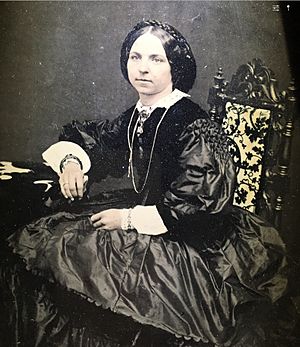Mary Gedye facts for kids
Quick facts for kids
Mary Harriet Gedye
|
|
|---|---|

Mary Gedye, hand coloured Daguerrotype ca. 1865, Eastbourne, Sydney
|
|
| Born |
Mary Harriet Wintle
1834 |
| Died | 1876 "Eastbourne"
|
| Nationality | Australian |
| Known for | Watercolourist |
| Spouse(s) | Charles Townsend Gedye |
| Awards | Sydney Intercolonial Exhibition 1870, New South Wales Academy of Art 1872 |
Mary Harriet Gedye (1834–1876) was a talented Australian artist who specialized in watercolour painting. She is known for her beautiful landscapes, especially those showing the mountains and coastal scenes of New South Wales.
Contents
Mary Harriet Gedye: A Talented Artist
Early Life and Artistic Journey

Mary Harriet Wintle was born in Hobart, Tasmania, in 1834. She was the second daughter of Samuel James Wintle and Mary Anne Magill. In 1839, when she was young, her family moved to Sydney.
Mary started drawing lessons when she was about seven years old. She first learned from a French artist named Madame Romansson. Later, she studied with the famous artist Conrad Martens. These early lessons helped her develop her artistic skills.
In 1852, Mary's talent was recognized when she won a gold medal for her watercolour painting at an exhibition in Paris. The next year, she married Charles T. Gedye, who lived at a place called Eastbourne in Darling Point, Sydney.
Her Amazing Artworks
After her marriage, Mary was able to focus more on her art. She also had three daughters. She painted many beautiful scenes, including a Tasmanian subject and famous views like View at Currajong and Waterboard Waterfalls. She also painted a lovely view of Port Jackson from her home, Eastbourne.
One of her watercolours, showing an Australian coastal scene, was painted in 1861. Another painting, On the Lane Cove, from December 1862, is kept at the Mitchell Library in Sydney.
Awards and Recognition
Mary Harriet Gedye's work was often shown in important exhibitions. In 1866, she displayed her painting View from Mount Bowen at an exhibition in Sydney. This exhibition was held before the big Paris Universal Exhibition. Even though other artists won the main prizes, the organizers greatly admired Mary's painting. They sent her a letter saying how much they appreciated her work. Her landscape was later shown in Paris the following year.
In 1870, she won a bronze medal at the Sydney Intercolonial Exhibition for her painting The Gap, Kurrajong. Many of her works, especially those showing the Blue Mountains, were lent to this exhibition by her husband. She continued to exhibit her art and won a prize for her painting Govett’s Waterfall in 1872 at the New South Wales Academy of Art.
Lasting Impact
Mary Gedye's art mainly focused on the stunning mountain scenery of New South Wales in the 1800s. She had hoped to visit Tasmania again to paint its beautiful landscapes, but she passed away in Sydney on January 31, 1876, at the age of 41. She died from a stroke at her home.
Her death was a great loss to the art world in Australia. An obituary published in the Hobart Town Mercury highlighted her Tasmanian roots and her successful career, stating that "The colonial art world suffers a serious loss by her untimely death." Her paintings continue to be admired for their beauty and historical significance.

